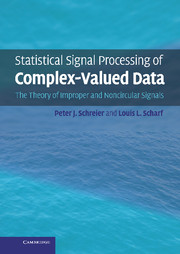Book contents
- Frontmatter
- Contents
- Preface
- Notation
- Part I Introduction
- 1 The origins and uses of complex signals
- 2 Introduction to complex random vectors and processes
- Part II Complex random vectors
- Part III Complex random processes
- Appendix 1 Rudiments of matrix analysis
- Appendix 2 Complex differential calculus (Wirtinger calculus)
- Appendix 3 Introduction to majorization
- References
- Index
1 - The origins and uses of complex signals
from Part I - Introduction
Published online by Cambridge University Press: 25 January 2011
- Frontmatter
- Contents
- Preface
- Notation
- Part I Introduction
- 1 The origins and uses of complex signals
- 2 Introduction to complex random vectors and processes
- Part II Complex random vectors
- Part III Complex random processes
- Appendix 1 Rudiments of matrix analysis
- Appendix 2 Complex differential calculus (Wirtinger calculus)
- Appendix 3 Introduction to majorization
- References
- Index
Summary
Engineering and applied science rely heavily on complex variables and complex analysis to model and analyze real physical effects. Why should this be so? That is, why should real measurable effects be represented by complex signals? The ready answer is that one complex signal (or channel) can carry information about two real signals (or two real channels), and the algebra and geometry of analyzing these two real signals as if they were one complex signal brings economies and insights that would not otherwise emerge. But ready answers beg for clarity. In this chapter we aim to provide it. In the bargain, we intend to clarify the language of engineers and applied scientists who casually speak of complex velocities, complex electromagnetic fields, complex baseband signals, complex channels, and so on, when what they are really speaking of is the x- and y-coordinates of velocity, the x- and y-components of an electric field, the in-phase and quadrature components of a modulating waveform, and the sine and cosine channels of a modulator or demodulator.
For electromagnetics, oceanography, atmospheric science, and other disciplines where two-dimensional trajectories bring insight into the underlying physics, it is the complex representation of an ellipse that motivates an interest in complex analysis. For communication theory and signal processing, where amplitude and phase modulations carry information, it is the complex baseband representation of a real bandpass signal that motivates an interest in complex analysis.
- Type
- Chapter
- Information
- Statistical Signal Processing of Complex-Valued DataThe Theory of Improper and Noncircular Signals, pp. 3 - 29Publisher: Cambridge University PressPrint publication year: 2010



